Integrative Study on Flow Characteristics and Impact of Non-Submerged Double Spur Dikes on the River System
Abstract
1. Introduction
2. Mathematical Model
2.1. Governing Equations
2.2. Grids and Boundary Conditions
2.3. Verification
3. Results and Discussions
3.1. Flow Structure
3.2. Turbulent Characteristics
3.3. Interaction between Double Spur Dikes (DSDs)
3.3.1. Lower Spur Dike (SD2) Acting on Upper Spur Dike (SD1)
3.3.2. Upper Spur Dike (SD1) Acting on Lower Spur Dike (SD2)
3.3.3. Discussion on the Spacing Threshold of Double Spur Dikes (DSDs)
4. Conclusions
Author Contributions
Funding
Institutional Review Board Statement
Informed Consent Statement
Data Availability Statement
Acknowledgments
Conflicts of Interest
References
- Uijttewaal, W. Effects of groyne layout on the flow in groyne fields: Laboratory experiments. J. Hydraul. Eng. 2005, 131, 782–791. [Google Scholar] [CrossRef]
- Cui, Z.; Zhang, X. Flow and sediment simulation around spur dike with free surface using 3-D turbulent model. J. Hydrodyn. 2006, 18, 237–244. [Google Scholar] [CrossRef]
- Azinfar, H.; Kells, J. Backwater prediction due to the blockage caused by a single, submerged spur dike in an open channel. J. Hydraul. Eng. 2008, 134, 1153–1157. [Google Scholar] [CrossRef]
- Duan, J.; He, L.; Fu, X.; Wang, Q. Mean flow and turbulence around experimental spur dike. Adv. Water Resour. 2009, 32, 1717–1725. [Google Scholar] [CrossRef]
- Yazdi, J.; Sarkardeh, H.; Azamathulla, H.; Ghani, A. 3D simulation of flow around a single spur dike with free-surface flow. Int. J. River Basin Manag. 2010, 8, 55–62. [Google Scholar] [CrossRef]
- Kuhnle, R.; Jia, Y.; Alonso, C. Measured and simulated flow near a submerged spur dike. J. Hydraul. Eng. 2008, 134, 916–924. [Google Scholar] [CrossRef]
- Zhang, X.; Wang, P.; Yang, C. Experimental study on flow turbulence distribution around a spur dike with different structure. Procedia Eng. 2012, 28, 772–775. [Google Scholar] [CrossRef]
- Ohmoto, T.; Hirakawa, R.; Watanabe, K. Effects of spur dike directions on river bed forms and flow structures. In Advances in Water Resources and Hydraulic Engineering: Proceedings of 16th IAHR-APD Congress and 3rd Symposium of IAHR-ISHS; Springer: Berlin/Heidelberg, Germany, 2009; Volume 3, pp. 957–962. [Google Scholar] [CrossRef]
- Ibrahim, M. Local bed morphological changes due to oriented groins in straight channels. Ain Shams Eng. J. 2014, 5, 333–341. [Google Scholar] [CrossRef]
- McCoy, A.; Constantinescu, G.; Weber, L. Hydrodynamics of flow in a channel with two lateral submerged groynes. In Proceedings of the World Environmental and Water Resources Congress, Tampa, Florida, 15–19 May 2007; Volume 2007, pp. 1–11. [Google Scholar] [CrossRef]
- Tominaga, A.; Matsumoto, D. Diverse Riverbed Figuration by Using Skew Spur-Dike Groups. River Flow 2006, 1, 683–691. Available online: http://apps.webofknowledge.com/full_record.do?product=WOS&search_mode=GeneralSearch&qid=1&SID=N2iurXVlKjBqvw2ejd5&page=1&doc=1 (accessed on 18 June 2015).
- McCoy, A.; Constantinescu, G.; Weber, L. Numerical Investigation of Flow Hydrodynamics in a Channel with a Series of Groynes. J. Hydraul. Eng. 2008, 134, 157–172. [Google Scholar] [CrossRef]
- Acharya, A.; Acharya, A.; Duan, J. Three Dimensional Simulation of Flow Field Around Series of Spur Dikes. Int. Refereed J. Eng. Sci. 2013, 2, 36–57. Available online: http://www.irjes.com/Papers/vol2-issue7/Version-2/F02073657.pdf (accessed on 3 May 2022).
- Cheng, N. Effective Range and Reasonable Layout of Groins. Port Waterw. Eng. 1991, 4, 28–31. Available online: http://www.cnki.com.cn/Article/CJFDTotal-SYGC199104008.htm (accessed on 3 May 2022).
- Ying, Q.; Jiao, Z. Hydraulics of Spur Dike; Ocean Press: Beijing, China, 2004. (In Chinese) [Google Scholar]
- Tang, X.; Ding, X.; Chen, Z. Large eddy simulations of three-dimensional flows around a spur dike. Tsinghua Sci. Technol. 2006, 11, 117–123. [Google Scholar] [CrossRef]
- Chau, K.W.; Wu, C.L. A hybrid model coupled with singular spectrum analysis for daily rainfall prediction. J. Hydroinf. 2010, 12, 458–473. [Google Scholar] [CrossRef]
- Azinfar, H. Flow Resistance and Associated Backwater Effect Due to Spur Dikes in Open Channels. Ph.D. Thesis, University of Saskatchewan, Saskatoon, Canada, 2010. Available online: http://ecommons.usask.ca/bitstream/handle/10388/etd-03012010-130940/HosseinAzinfarPHDThesis.pdf (accessed on 18 June 2015).
- Cao, X.; Gu, Z.; Tang, H. Study on spacing threshold of nonsubmerged spur dikes with alternate layout. J. Appl. Math. 2013, 2013, 1–8. [Google Scholar] [CrossRef]
- Kalita, H.M.; Sarma, A.K.; Bhattacharjya, R.K. Evaluation of optimal river training work using GA based linked simulation-optimization approach. Water Resour. Manag. 2014, 28, 2077–2092. [Google Scholar] [CrossRef]
- Cao, X.; Gu, Z. Three classification criteria and their comparison impact scale between double non-submerged spur dikes. J. Zhejiang Univ. 2015, 49, 200–207. [Google Scholar] [CrossRef]
- Li, Z.; Li, H.; Li, J.; Li, R. Experimental study and numerical simulation of flow in the vicinity of a submerged spur-dike. J. Hydraul. Eng. 2003, 34, 53–57. [Google Scholar] [CrossRef]
- Mohammad, V.; Yaser, S.; Shaker, H.S. Effects of distance between the T-shaped spur dikes on flow and scour patterns in 90° bend using the SSIIM model. Ain Shams Eng. J. 2016, 7, 31–45. [Google Scholar] [CrossRef]
- Gao, X.; Liu, H.; Hua, G.; Wang, Z. Rational spacing characters of double permeable spur. J. Shihezi Univ. 2010, 28, 614–617. [Google Scholar] [CrossRef]
- James, R. Defining and measuring river health. Freshw. Biol. 1999, 41, 221–234. [Google Scholar] [CrossRef]
- Richard, H.; Martin, C. What is river health? Freshw. Biol. 1999, 41, 197–209. [Google Scholar] [CrossRef]
- Pinter, N.; Jemberie, A.; Remo, J.; Heine, R.; Ickes, B. Cumulative impacts of river engineering, Mississippi and lower Missouri Rivers. River Res. Appl. 2010, 26, 546–571. [Google Scholar] [CrossRef]
- Wohl, E. Identifying and mitigating dam-induced declines in river health: Three case studies from the western United States. Int. J. Sediment Res. 2012, 27, 271–287. [Google Scholar] [CrossRef]
- Cui, Z.; Zhang, X. Flow simulation of spur dike using 3-D turbulent model. Eng. J. Wuhan Univ. 2006, 39, 15–20. [Google Scholar] [CrossRef]
- Molls, T.; Chaudhry, M.; Khan, K. Numerical simulation of two-dimensional flow near a spur-dike. Adv. Water Resour. 1995, 18, 227–236. [Google Scholar] [CrossRef]
- Zhou, Y.; Michiue, M.; Hinokidani, O. Study on flow characteristics around the non-submerged spur-dikes. J. Hydraul. Eng. 2004, 35, 46–53. [Google Scholar] [CrossRef]
- Karvinen, A.; Ahlstedt, H. Comparison of Turbulence Models in Case of Three-Dimensional Diffuser. In Proceedings of the Open Source CFD International Conference, Berlin, Germany, 4–5 December 2008; p. 17. Available online: http://powerlab.fsb.hr/ped/kturbo/openfoam/Berlin2008/PosterSession/OSCIC-08_KarvinenAku.pdf (accessed on 7 July 2015).
- Fluent Inc. FLUENT 6.3 User’s Guide. 2006. Available online: https://www.sharcnet.ca/Software/Fluent6/pdf/ug/flug.pdf (accessed on 7 July 2015).
- Ettema, R.; Muste, M. Scale effects in flume experiments on flow around a spur dike in flatbed channel. J. Hydraul. Eng. 2004, 130, 635–646. [Google Scholar] [CrossRef]
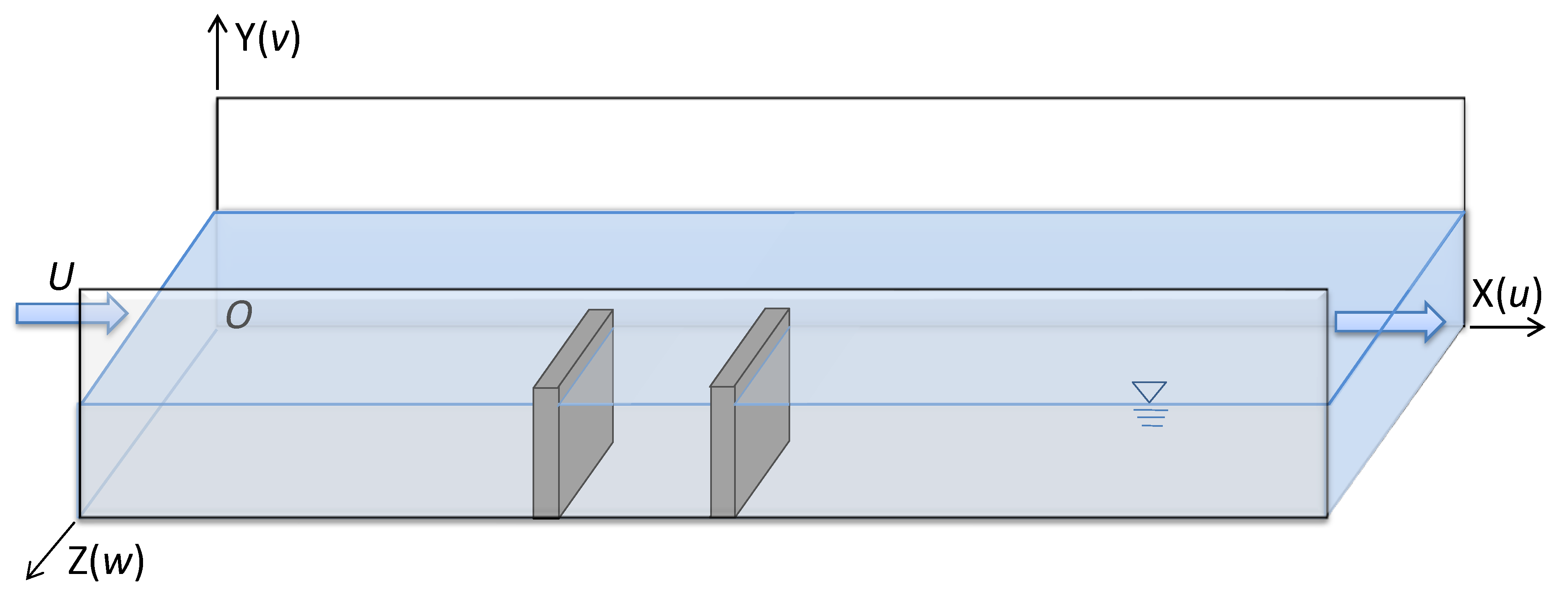

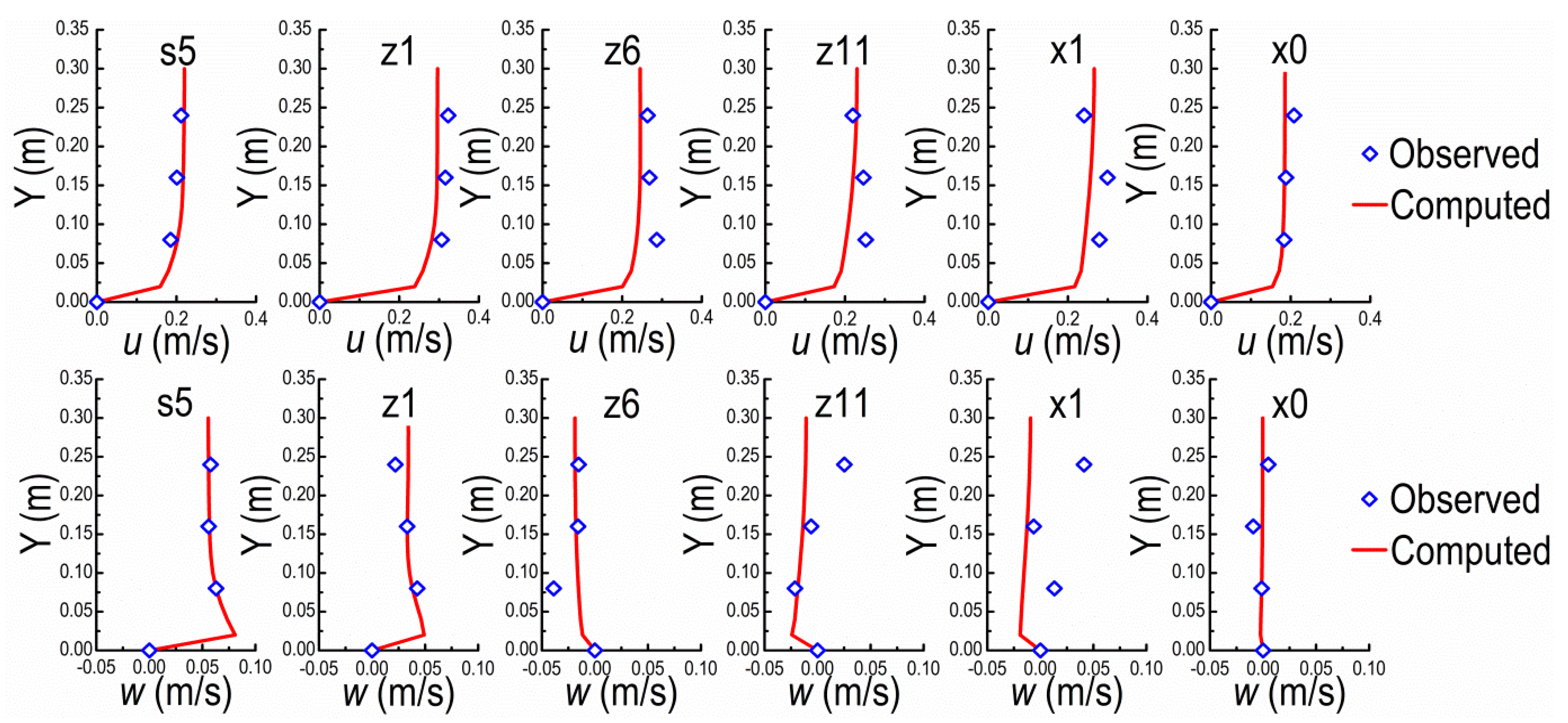
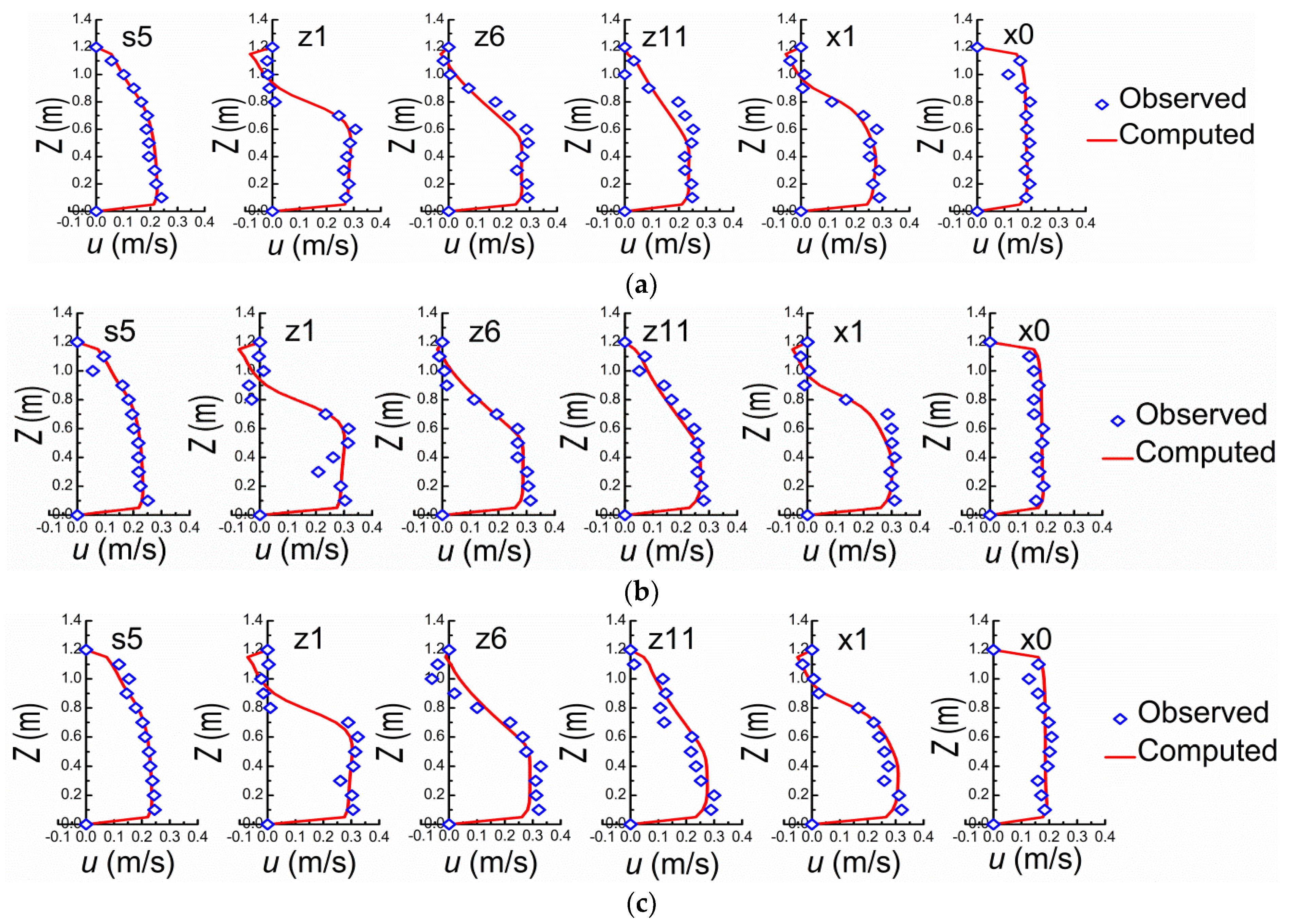
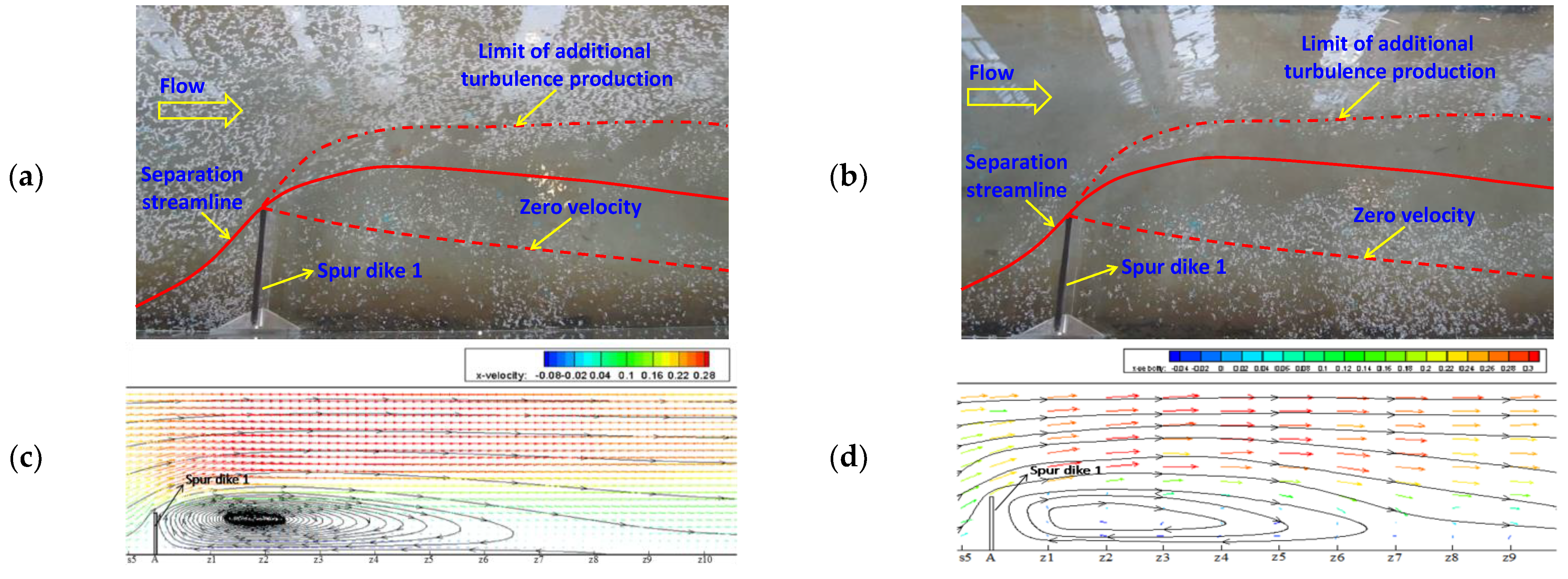
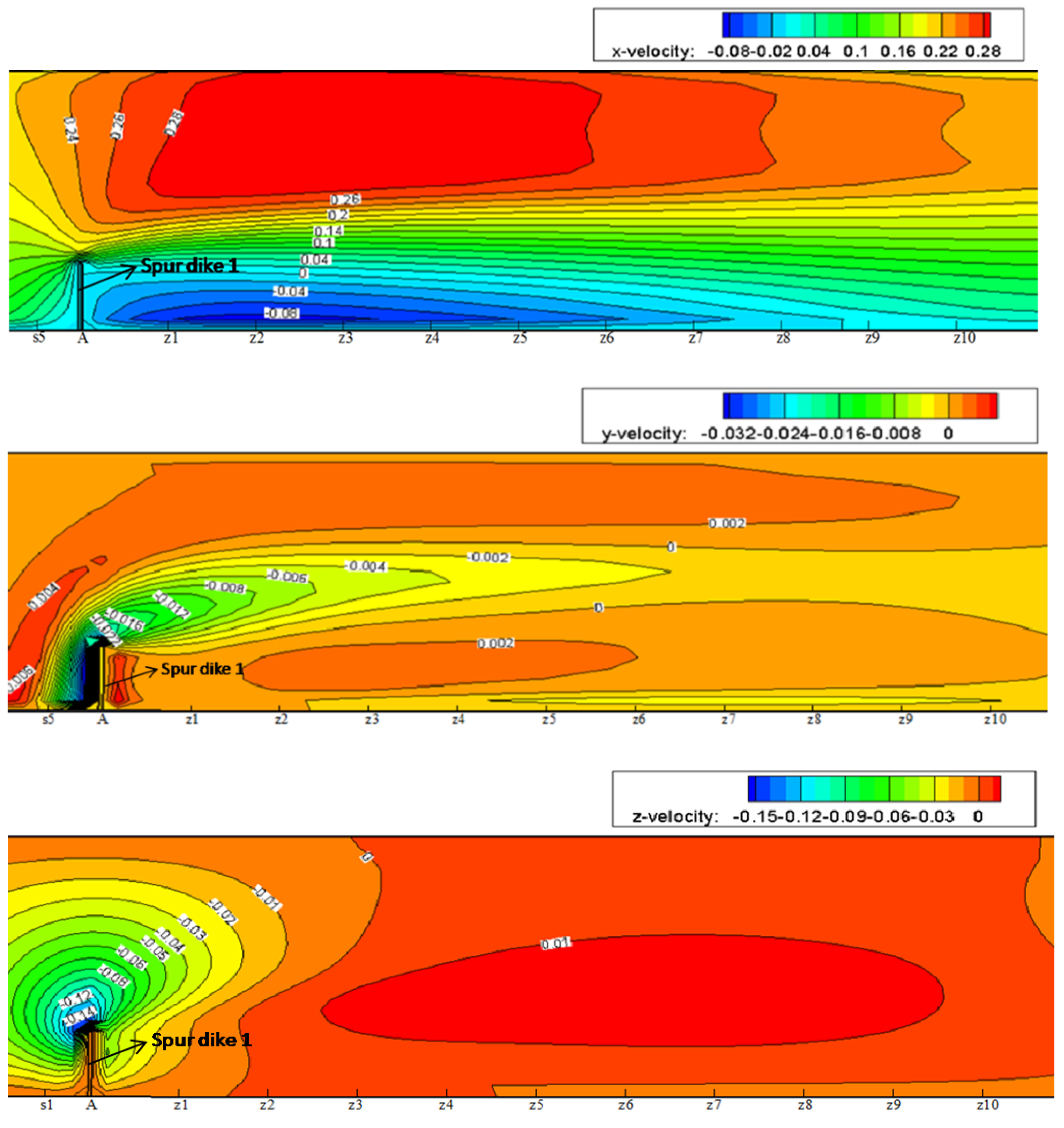


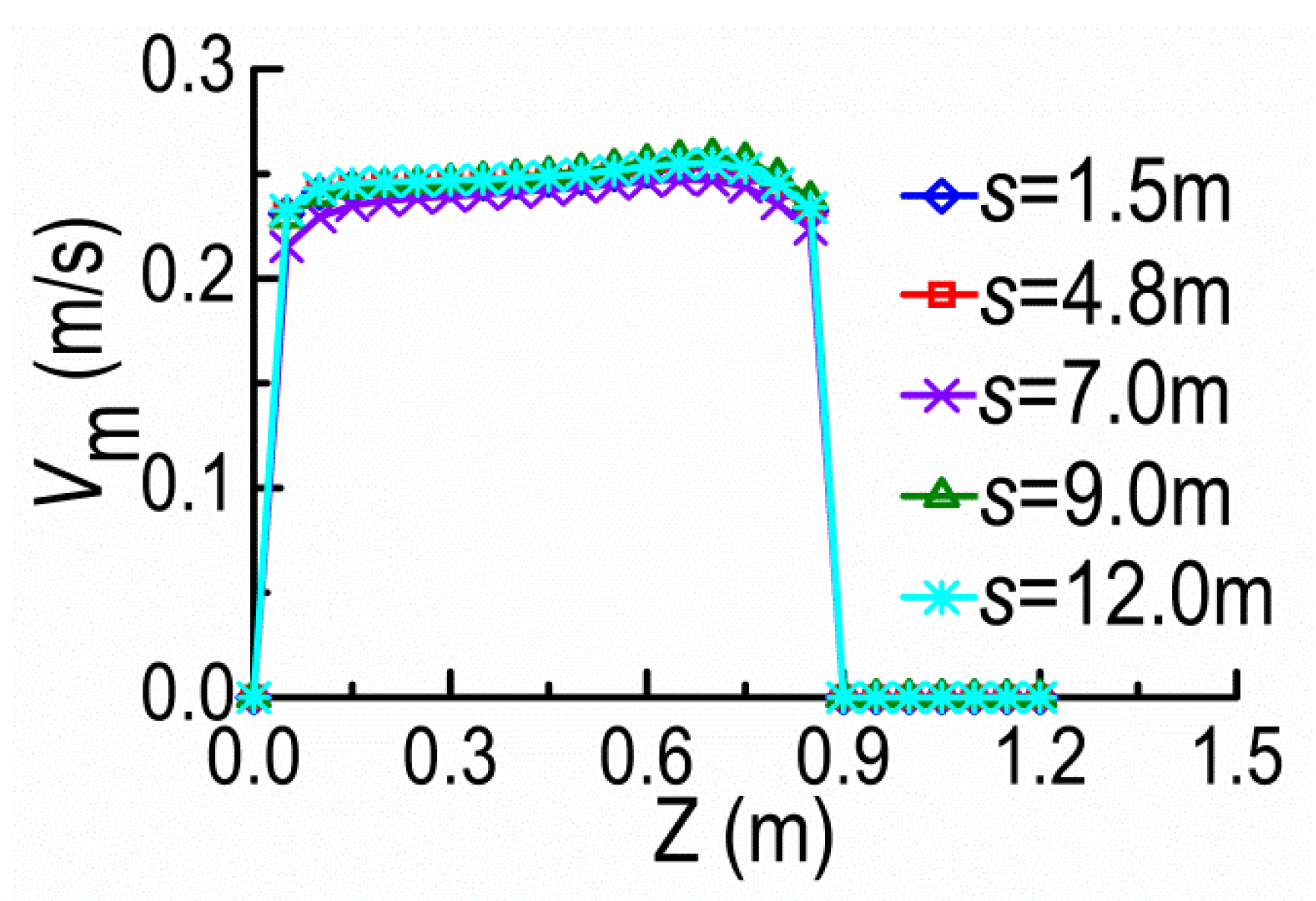
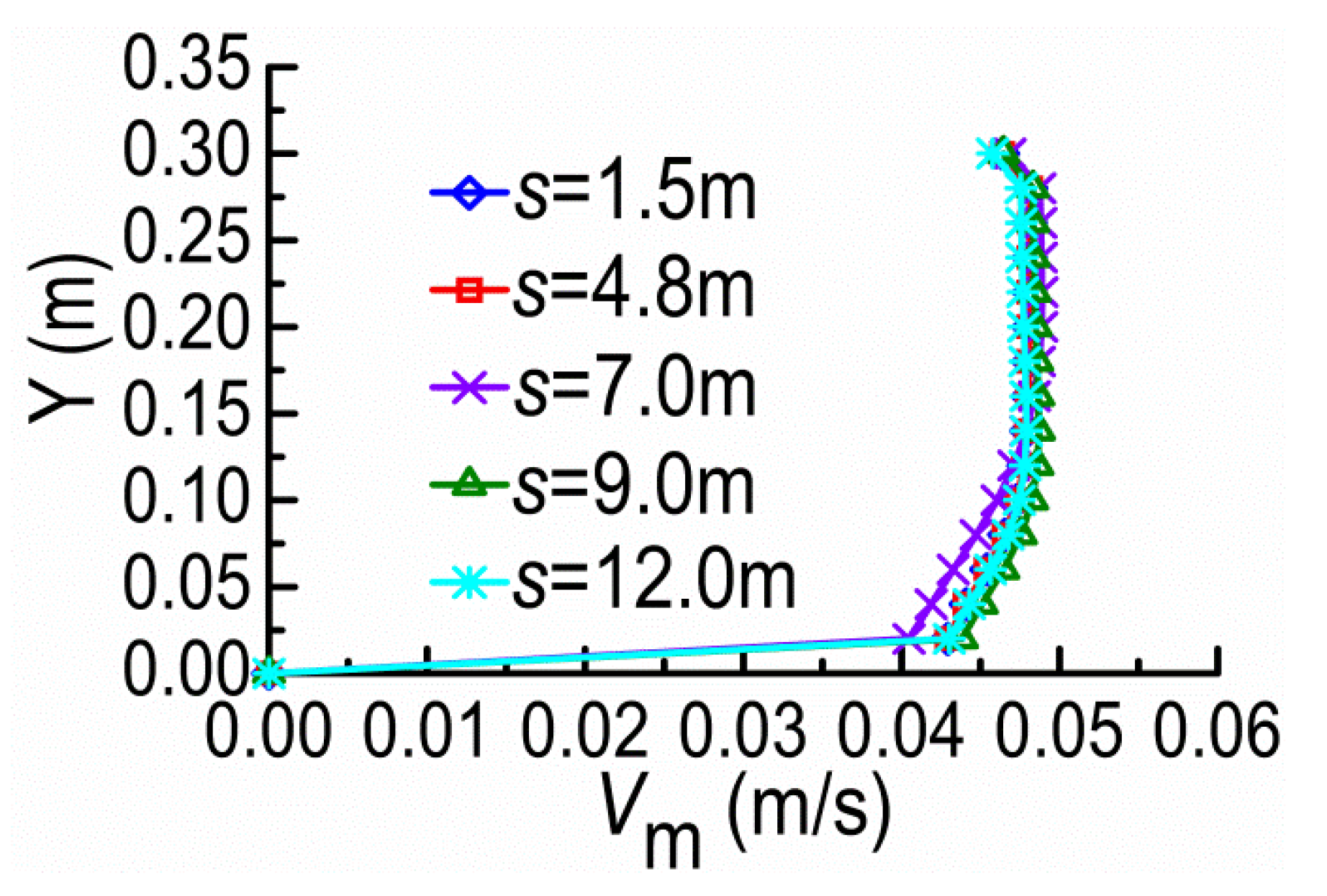
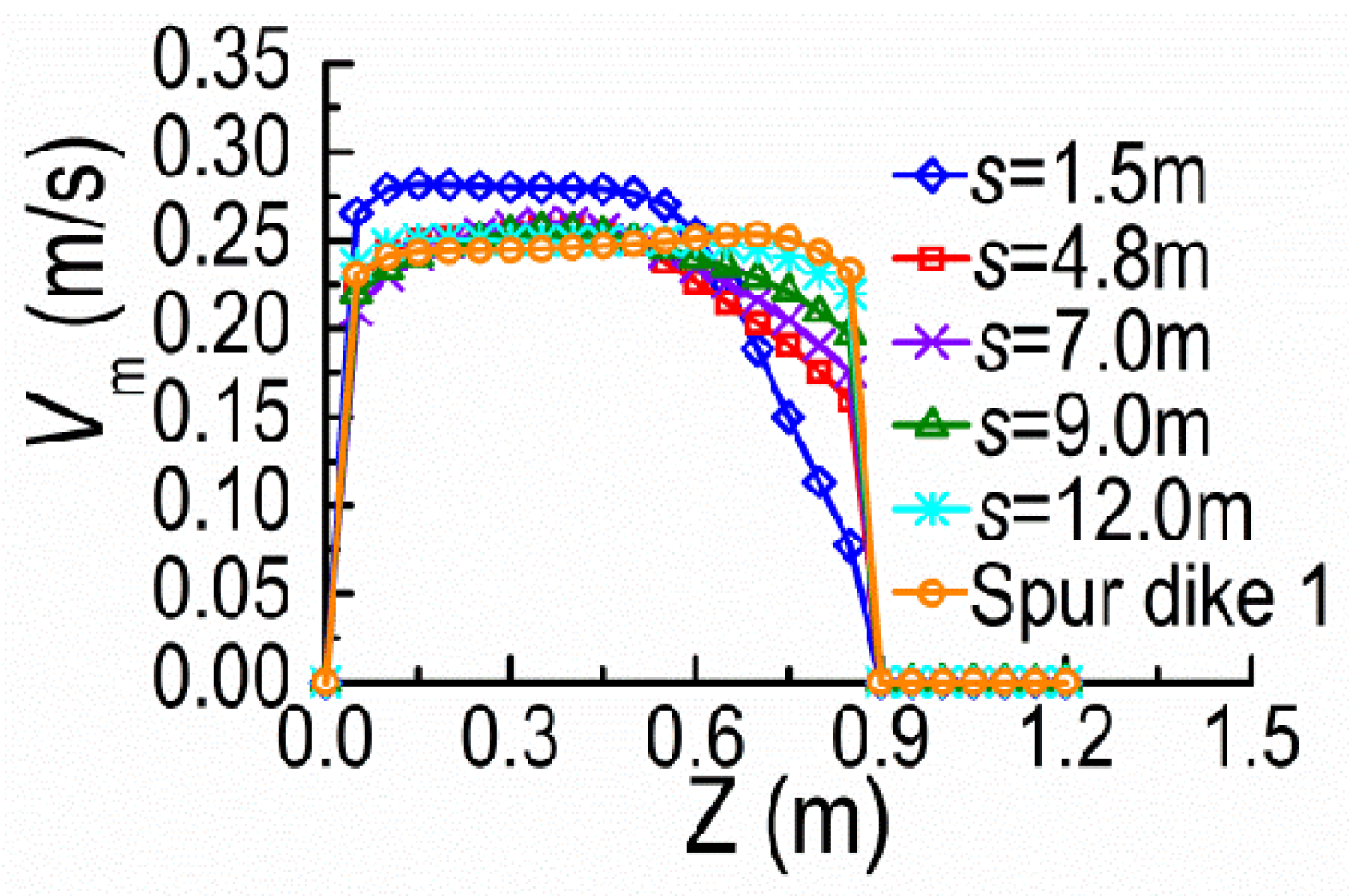
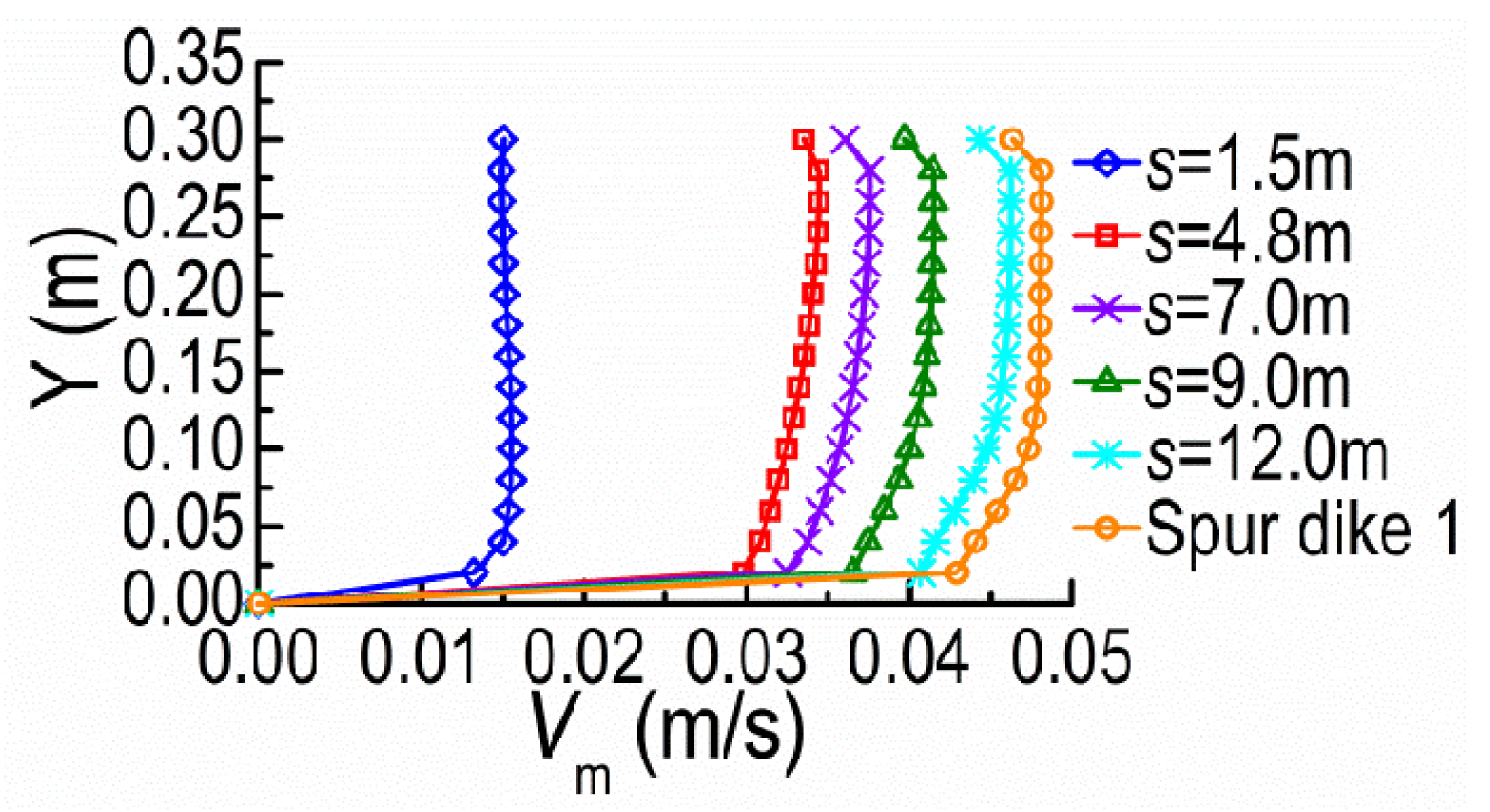
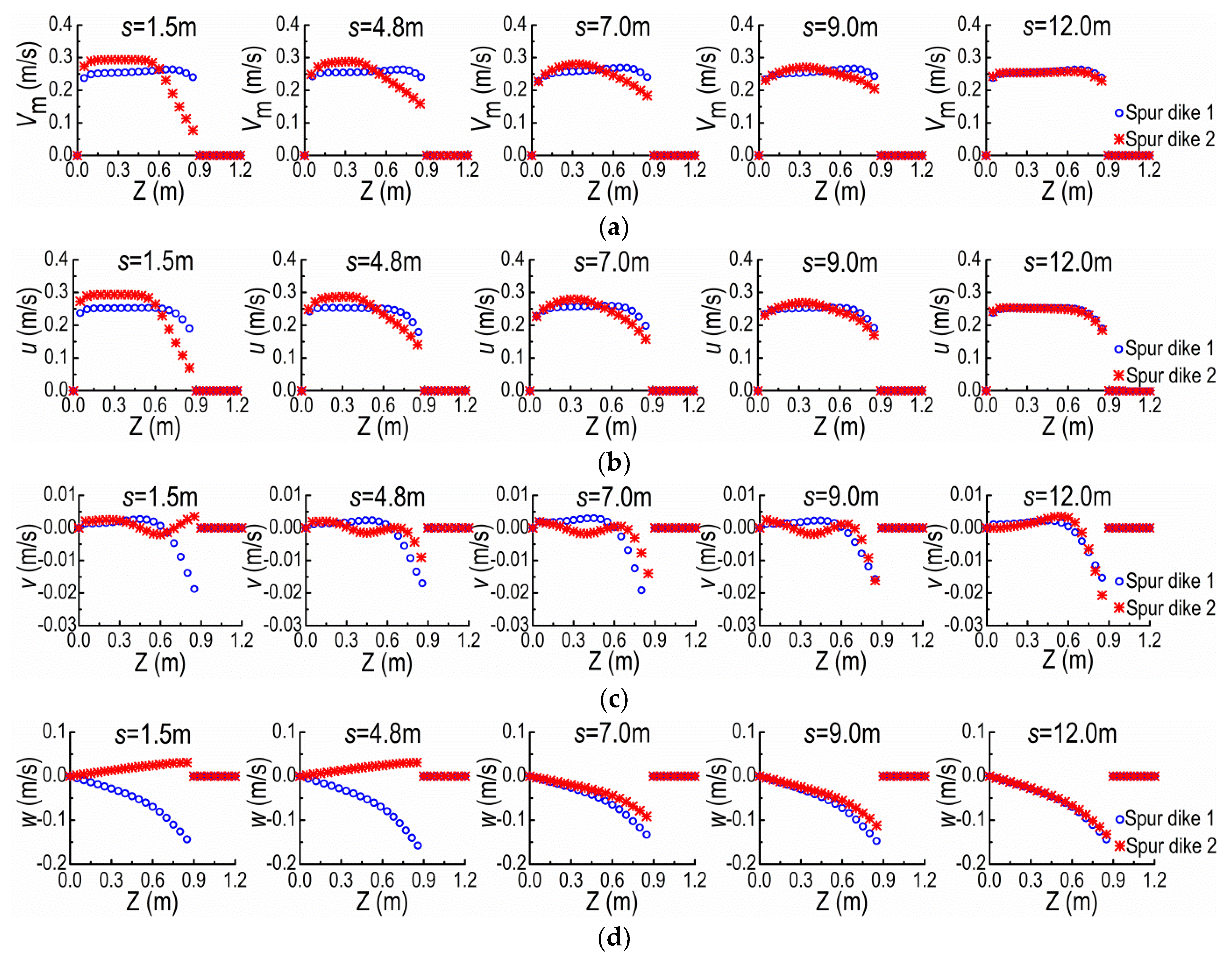
Disclaimer/Publisher’s Note: The statements, opinions and data contained in all publications are solely those of the individual author(s) and contributor(s) and not of MDPI and/or the editor(s). MDPI and/or the editor(s) disclaim responsibility for any injury to people or property resulting from any ideas, methods, instructions or products referred to in the content. |
© 2023 by the authors. Licensee MDPI, Basel, Switzerland. This article is an open access article distributed under the terms and conditions of the Creative Commons Attribution (CC BY) license (https://creativecommons.org/licenses/by/4.0/).
Share and Cite
Gu, Z.; Cao, X.; Cao, M.; Lu, W. Integrative Study on Flow Characteristics and Impact of Non-Submerged Double Spur Dikes on the River System. Int. J. Environ. Res. Public Health 2023, 20, 4262. https://doi.org/10.3390/ijerph20054262
Gu Z, Cao X, Cao M, Lu W. Integrative Study on Flow Characteristics and Impact of Non-Submerged Double Spur Dikes on the River System. International Journal of Environmental Research and Public Health. 2023; 20(5):4262. https://doi.org/10.3390/ijerph20054262
Chicago/Turabian StyleGu, Zhenghua, Xiaomeng Cao, Minxiong Cao, and Weizhen Lu. 2023. "Integrative Study on Flow Characteristics and Impact of Non-Submerged Double Spur Dikes on the River System" International Journal of Environmental Research and Public Health 20, no. 5: 4262. https://doi.org/10.3390/ijerph20054262
APA StyleGu, Z., Cao, X., Cao, M., & Lu, W. (2023). Integrative Study on Flow Characteristics and Impact of Non-Submerged Double Spur Dikes on the River System. International Journal of Environmental Research and Public Health, 20(5), 4262. https://doi.org/10.3390/ijerph20054262








